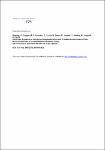Confirmed Exposure to Tick-Borne Encephalitis Virus and Probable Human Cases of Tick-Borne Encephalitis in Central/Northern Anatolia, Turkey
Ergünay, Koray
Saygan, Mehmet B.
Aydoğan, Sibel
Litzba, Nadine
Sener, B.
Lederer, Sabine
Niedrig, Matthias
Hasçelik, G.
Us, Dürdal
Tick-borne encephalitis virus (TBEV) is the aetiological agent of tick-borne encephalitis (TBE), a potentially fatal central nervous system infection of humans. TBE is endemic in many areas of Europe and Asia; however, very scarce data on TBEV activity are available from Turkey. We aimed to identify TBEV exposure in healthy blood donors and the impact of TBEV in central nervous system infections in Central/Northern Anatolia. Two-thousand four hundred and fifty four sera, collected from blood donors at Ankara, Konya, Eskişehir and Zonguldak branches of the Turkish Red Crescent Middle Anatolia Regional Blood Center, were analysed for TBEV serosurveillance. Paired serum and cerebrospinal fluid samples from 108 patients with the diagnosis of aseptic meningitis/encephalitis of unknown aetiology were also evaluated to identify TBE and neuroborreliosis cases. Commercial enzyme-linked immunosorbent assays and indirect immunofluorescence tests were employed for antibody detection. Forty-seven donor samples (1.9%) were reactive for TBEV IgG. In 25 persons with IgG reactivity (53.1%), risk factors for tick-borne infections were revealed. One sample from Zonguldak province (1/198; 0.5%) in the Black Sea region of Turkey was confirmed to possess neutralizing antibodies via plaque reduction neutralization test. TBEV IgM was detected in 9.2% (8/108) of the patients. IgM was accompanied by IgG reactivity in two persons where, in one, recent history of a tick bite was also identified. Intrathecal antibody production for TBEV could not be demonstrated. No evidence for Borrelia infections could be found. Confirmed exposure to TBEV and/or an antigenically similar tick-borne flavivirus is documented for the first time in blood donors in Zonguldak in Northern Anatolia. Probable cases of TBE have also been identified from Central Anatolia. The epidemiology of TBEV activity in Turkey needs to be assessed and benefits of vaccination for general population, risk groups or travellers must be considered.
Dateien zu dieser Publikation
Keine Lizenzangabe

